Arabic miniatures (Arabic: ٱلْمُنَمْنَمَات ٱلْعَرَبِيَّة, Al-Munamnamāt al-ʿArabīyyah) are small paintings on paper, usually book or manuscript illustrations but also sometimes separate artworks that occupy entire pages. The earliest example dates from around 690 AD, with a flourishing of the art from between 1000 and 1200 AD in the Abbasid caliphate. The art form went through several stages of evolution while witnessing the fall and rise of several Islamic caliphates. Arab miniaturists absorbed Chinese and Persian influences brought by the Mongol destructions, and at last, got totally assimilated and subsequently disappeared due to the Ottoman occupation of the Arab world. Nearly all forms of Islamic miniatures (Persian miniatures, Ottoman miniatures and Mughal miniatures) owe their existences to Arabic miniatures, as Arab patrons were the first to demand the production of illuminated manuscripts in the Caliphate, it wasn't until the 14th century that the artistic skill reached the non-Arab regions of the Caliphate.[1][2][3][4][5][6]
Despite the considerable changes in Arabic miniature style and technique, even during their last decades, the early Umayyad Arab influence could still be noticed. Arabic miniature artists include Ismail al-Jazari, who illustrated his own Book of Knowledge of Ingenious Mechanical Devices,[7] and the Abbasid artist, Yahya Al-Wasiti, who probably lived in Baghdad in the late Abbasid era (12th to 13th-centuries), was one of the pre-eminent exponents of the Baghdad school. In 1236-1237, he is known to have transcribed and illustrated the book, Maqamat (also known as the Assemblies or the Sessions), a series of anecdotes of social satire written by Al-Hariri of Basra.[8] The narrative concerns the travels of a middle-aged man as he uses his charm and eloquence to swindle his way across the Arabic world.[9]
With most surviving Arabic manuscripts in western museums,[10] Arabic miniatures occupy very little space in modern Arab culture.[11]
Origins
Non-figurative ornaments in early Mus'hafs
The following manuscripts are listed in a chronological order, it should be noted however that the date estimates of a codex may be concurrent or similar to those of other manuscripts due to the wide range of date estimates offered by radiocarbon dating:[12][13][14]
The Birmingham Quran manuscript is a parchment on which two leaves of an early Quranic manuscript are written. In 2015 the manuscript, which is held by the University of Birmingham,[15] was radiocarbon dated to between 568 and 645 CE (in the Islamic calendar, between 56 BH and 25 AH).[16][17] It is part of the Mingana Collection of Middle Eastern manuscripts, held by the university's Cadbury Research Library.[16] The manuscript is written in ink on parchment, using an Arabic Hijazi script and is still clearly legible.[17] The leaves preserve parts of Surahs 18 (Al-Kahf) to 20 (Taha).[18] It was on display at the University of Birmingham in 2015 and then at Birmingham Museum and Art Gallery until 5 August 2016.[19] The Cadbury Research Library has carried out multispectral analysis of the manuscript and XRF analysis of the inks.[20]
There are no diacritical marks to indicate short vowels, but consonants are occasionally differentiated with oblique dashes. The text is laid out in the format that was to become standard for complete Quran manuscripts, with chapter divisions indicated by a decorated line in the form of basic geometric shapes painted with red lead, an ancient pigment used from 300 BCE onwards, such motifs vary in color and shapes in this manuscript, in one folio, three wavy threads of orange-red colour separated by dots run parallel over the entire span of the page, In the outer margin, the three lines are interlaced to draw a highly stylized palm leaf, in another folio, the separator is covered with blackheads. The verse endings are indicated by intertextual clustered dots.[21][22][23]
In the codex Parisino-petropolitanus, one of the oldest extant manuscripts of the Quran. With its largest part of the fragmentary manuscript being held at the Bibliothèque nationale de France, Paris, as BnF Arabe 328(ab), with 70 folia. And another 46 folia are kept in the National Library of Russia in Saint-Petersburg.
Two additional folia have been preserved, one kept in the Vatican Library (Vat. Ar. 1605/1) and the other in the Khalili Collections in London (KFQ 60), attributed to the 7th century, six oval dots ranked in three pairs also punctuate the verses. Every fifth verse is marked by a red alif surrounded by dots (rather than hollow circles like in Codex B. L. Or. 2165). The surahs are separated by a space.[24][25][26]
In the Codex B. L. Or. 2165, a Qur'ānic manuscript from the 1st century Hijra, with its fragments in the British Library, London (United Kingdom); Bibliothèque Nationale, Paris (France) and in Dār al–Athar al–Islāmiyyah, Kuwait city (Kuwait). Six oval dots ranked in three pairs punctuate the verses. Every tenth verse is marked by a red hollow circle surrounded by dots.[27][28][29]
Simple ornaments of the borders and openings of the surahs in the pages of the 1st century hijra Qur'ans are also found. A notable example is the TIEM ŞE 321 Mus'haf (This manuscript belongs to the Şam Evrakı ‘Papers of Syria’ collection, at the Turkish and Islamic arts Museum). The surah headings of this codex are illuminated but do not represent the text found in the pages. The decorations of this Qur'an resembles those of the Umayyad mosaics of the Dome of the Rock in Jerusalem. It's dated to the period after 72 AH / 691–692 CE or more probably during the last quarter of the 1st (early 8th) century hijra.[30][31][32]
The “Umayyad Codex of Fusṭāṭ” (Codex Marcel 13) of the 1st century of hijra, is a manuscript that may have been one of the mus'hafs that were sent by al-Hajjaj to many important cities including Fusṭāṭ that contained reformed orthography, it is written in the Kufic or perhaps late ḥijāzī script.
This copy was written with 25 lines to the page on folios in vertical format. The average height of the line is about 11.5 mm. With homogenous quires with five bifolios. The surah headings of this codex are illuminated but irregularly.[33]
Another manuscript housed in the Turkish and Islamic Arts Museum is the "Qur'an of 'Uthman", due to its colophon that attributes the scribal work of the mus'haf to 'Uthman bin' Affan, the third Rashidun caliph, however, the style of script and decorations seems to go against this claim. Therefore, it is more likely that this manuscript dates back to the second half of 1st century or first half of 2nd century hijra. The codex was restored by Dāwūd bin ʿAlī al-Kaylānī on 3 December 1437 CE.
The manuscript is written on parchment made out of gazelle skin. While the folios from the restoration of 1437 CE are made out of paper. Every tenth ayah is marked with a circular gold medallion surrounded by blue, green, and red dots.[34][35][36][37][38]
The Topkapi Mushaf, also called “Qur'ān Of ʿUthmān” (Topkapi Museum, Istanbul, Turkey), From 1st / 2nd Century Hijra, is traditionally attributed to Uthman Ibn Affan. But the paleographic assessment indicates that the Topkapi manuscript comes closest to those writings that date back to the 8th century. Its illuminations are similar to those found in the Dome of the Rock in Jerusalem, the Umayyad Mosque in Damascus and other Umayyad monuments.
Its surahs are separated by ornamented horizontal bands. The manuscript also contains large circular rosettes, these are found after every 5 and 10 Ayahs, while rectangular shaped signs are found after every 100 verses and signs of similar shape following every 200 verses in some surahs.[39][40]
As for the “Qur'ān Of ʿUthmān” (also known as the Uthman Quran, Samarkand codex, Samarkand manuscript and Tashkent Quran) at Tashkent (Samarkand), Uzbekistan, based on orthographic and palaeographic studies, it probably dates from the 8th or 9th century.[41] Radio-carbon dating shows a 95.4% probability of a date between 775 and 995.[41] However, one of the folios from another manuscript (held in the Religious Administration of Muslims in Tashkent) was dated to between 595 and 855 A.D. with a likelihood of 95%.[41]
Written in the territory of modern Iraq in the Kufic script. Now kept in the Hast Imam library, in Tashkent, Uzbekistan.[42][43] Its verse endings are marked by small panels of diagonals lines; the tenth verse is marked with a square medallion illuminated in blue, green, red and manganese with a stellar design.[44]
Emergence of Arabic miniatures
The only surviving Arabic illuminated manuscript dating from before the 11th century is the "Great Umayyad Qur'an". Found in the Great Mosque in Sana'a, ornamentation of this manuscript incorporated motifs that are very similar to those used to decorate the Dome of the Rock, the Great Mosque of Damascus and the desert castles of Umayyads. Because of this the time of production of this Qur'an has been narrowed to between 691 and 743 CE. It is the only lavishly illuminated Qur'an codex extant that can be securely placed in the Umayyad period. It's currently housed in the Dar al-Makhtutat. The manuscript includes full illustrations that take up entire pages, and also sūrah dividers and ornamental borders. One of the miniatures representing Jannah is based on a cosmogram, and, on the reverse, a mosque.[4]
_on_parchment_(Qur'anic_verses).jpg.webp)
Rise
The first illustrated Arabic manuscript still preserved from the 11th century is Abd al-Rahman al-Sufi's Book of Fixed Stars, dated from around 1009 (Bodleian Library, Marsh144). This astronomy work was copied by the author's son himself, from models that already existed in the previous century. It is then necessary to wait until the end of the twelfth century to find a boom in miniatures in the Arab world.[45]
Development
Abbasid Caliphate (750–1258)
Several Islamic monarchs enjoyed a long reign, such as the Abbasid caliph An-Nasir or the regent then king of Mosul Badr al-Din Lu'lu' (1218-1259), contributing to the prosperity of the region and the emergence of a rich cultural background. It is also in this city the class of wealthy merchants were likely to order such works. The manuscripts still conserved today correspond to the end of this period of prosperity, the first half of the fourteenth century.[46]
The Arab society present at that time showed a great interest in theatrical shows and particularly in puppets and shadow theatre. The appearance of the characters depicted in the miniatures are reminiscent of the figurines from these shows. In addition, the epoch featured a great enthusiasm for the sessions or Maqamat al-Harīrī, tales featuring a jester character to whom many adventures happen. The combination of these elements of interest may explain the commissioning of illuminated manuscripts of this text. It also explains the birth of a new genre of painting, representing realistically the details of daily life contemporary to the painter of the illustration. Finally, this emergence of the image is also explained by the weakening of the ban on figurative representation in the arts during this period.[47] One of the most famous centers in the Arab world was the Baghdad School, also known as the Arab school, it was a relatively short-lived yet influential center of Arab art developed during the late 12th century in the capital Baghdad of the ruling Abbasid Caliphate. The movement had largely died out by the early 14th century, five decades following the invasion of the Mongols in 1258 and the downfall of the Abbasids' rule.

Fatimid Caliphate (909–1171)
Another example are the Fatimids who fueled a renaissance in Arabic figurative arts, thus developing a stylized and distinct style. The prevalence of books within the Fatimid empire was demonstrated by the existence of the Dār al-'Ilm, or the House of Knowledge. In 1045 CE, the Dār al-'Ilm was reported to contain 6,500 volumes[48] of scientific and literary subjects. When the Fatimid dynasty dissolved during the twelfth century, the libraries and collections of books that existed in Cairo were dispersed, making it difficult to locate any complete manuscripts.[49] Only fragments of text and paper are able to provide information of the content and style of Fatimid manuscripts.
It is rare to have an example of both text and illustrations of the same page, which makes it difficult to gather information about illuminated manuscripts. In some cases, it is possible that illustrations were added to an already existing text at a later date.[48] Fatimid illustration style can be demonstrated by one surviving piece of paper, which was excavated in Cairo. This single sheet of paper has drawings on both sides; one side showing a lion, and the other, a hare. While it is unclear whether this page originated from a work of, potentially, scientific or zoological subject matter, it is an example of larger patterns of naturalistic and figural representation within Fatimid art.[50]
Mamluk Sultanate (1250–1517)
Mamluk painting marks the last revival of miniature paintings in the Arab world. In this style, a more rigid style is found most commonly. A new interest is developed in the field of war treatises. Formalism is the main characteristic of the manuscripts of this period: the decorations are schematic and reduced to a minimum, geometric compositions, stylized folds of clothing. The features of the characters sometimes take on those of Mongol rulers, depicting "Asian eyes", similar to those of certain turkic Mamluk emirs and monarchs. The oldest manuscript of this style dates back to 1273 with Ibn Butlan's Banquet of the Physicians (Ambrosian Library, A.125 Inf.). One of the most exemplary manuscripts of this style is the Maqamat of Vienna, probably painted in Egypt in 1334.[51]
Cairo, Damascus, and Aleppo were among the main centers of manuscript production. Mamluk-period Qur'ans were richly illuminated and exhibit stylistic similarities with those produced under the contemporary Ilkhanids in Iran.[52] The production of high-quality paper at this time also allowed for pages to be larger, which in turn encouraged artists to elaborate new motifs and designs to fill these larger formats. Some manuscripts could be monumental in size; for example, one Qur'an manuscript produced for Sultan Sha'ban measured between 75 and 105 cm (30–41 in) tall.[52] One of the stylistic features that distinguished Mamluk manuscript decoration was the presence of gilded foliate scrollwork over pastel-coloured backgrounds set within wide margins. Frontispieces were often decorated with star-shaped or hexagonal geometric motifs.[52]
Decline
The sack of Baghdad in 1258 by the Mongol armies marked the beginning of a decline in the art of illuminated books. The miniature survived in Syria and Egypt, under Mamluk rule, however, the style became less refined, and more naïve. With the fall of the Mamluks following the Battle of Anjar, most Arab countries became peripheral regions of the Ottoman and Persian empires and only the centers far away from the Arab world of these empires perpetuated this art.[53]
Mongol rule
Arab miniaturists had to adapt to the tastes of their new rulers and the Mongols who brought with them Chinese influences. This influence is felt in particular in the book of Manafi' al-hayawan by Ibn Bukhtishu (Pierpont Morgan Library, M.500), the Vestiges of the past of the University of Edinburgh (Ms.161) dated 1307 or even The marvels of creation and their peculiarities from the Bavarian State Library (C.Ar.464). However, this art continued regressing, Iraq gradually becoming a satellite region of the Ilkhanate and the network of local sponsors gradually disappeared.[54]
 kitab fawa'id al hayawan, Pierpont Morgan Library
kitab fawa'id al hayawan, Pierpont Morgan Library ʿAjāʾib al-makhlūqāt wa-gharāʾib al-mawjūdāt, library of Bavaria
ʿAjāʾib al-makhlūqāt wa-gharāʾib al-mawjūdāt, library of Bavaria
Last traces
One of the last important illustrated Arabic manuscripts is a copy of Al-Qazwini's Wonders of Creation dated around 1370 and 1380 in Baghdad (Freer Gallery of Art, 54.33-114). It shows both Mongol and Persian influences, although it still remains faithful to the caliphal classical Arabic tradition. Subsequently, the few rare manuscripts still produced in this region lost their originality and almost totally assimilated to the Ottoman or Persian style.[55]
Influences
Figurative art has been known to Arabs since pre-Islamic times. Many examples of figurative representations such as frescoes and reliefs of humans and animals adorn the palaces of the Umayyad period, as on the Mshatta Facade,[56] or the desert castles of the Levant, or the harems of the Abbasid era.[57]
Persian influence
Several Arabic manuscripts have frontispieces representing princes surrounded by their courts. Among these works, although intended for commoners, wealthy merchants or others, some have retained the frontispiece of the Persian manuscripts from which they were inspired. These prince portraits represent hieratic (highly formalised) and frozen characters. These are generally literary works intended for entertainment.[58]
 Page of a manuscript of the Kitāb al-Aghānī, 13th century AD.
Page of a manuscript of the Kitāb al-Aghānī, 13th century AD.
Syro-Byzantine influences
At the end of the twelfth century, a new influence appeared; it was medieval painting that came through Byzantine illumination developed in Syria. Christian iconography was taken up but adapted to the Muslim context. The manuscript of Dioscorides of Topkapi takes up models taken from Byzantine manuscripts that can be found in the Dioscorides of Vienna copied in Constantinople in the sixth century. But this influence can be found in manuscripts without any relation with ancient subjects, as in several manuscripts of the Maqamat. For example, In the Hariri of 1222 (BNF Ar.6094), the figures in the miniatures wear turbans while having Byzantine features and attitudes close to Christ or his apostles.[59]
 Dioscorides of Topkapi
Dioscorides of Topkapi Book of Selected Maxims and Aphorisms of Al-Mubashshir, palace of topkapi.
Book of Selected Maxims and Aphorisms of Al-Mubashshir, palace of topkapi.
Materials and techniques
| Color(s) | Source(s) |
|---|---|
| Red/pink
أَحْمَر/وَرْدِي |
|
| Yellow
أَصْفَر |
|
| Blue
أَزْرَق |
Plant-based substances such as:
|
| White
أَبْيَض |
|
| Brown
بُنِيّ |
|
| Green
أَخْضَر |
Green was achieved by using a base of copper, such as: |
Types
Two types of works were illustrated; scientific books and literary manuscripts. Baghdad, Mosul and northern Syria were the main centers for the manufacturing of manuscripts, usually the origin of the works is often difficult to determine.
Scientific manuscripts (الْمَخْطُوطَات الْعِلْمِيَّة)
The main field in which illustrated manuscripts proliferated were scientific works. Usually bestiaries, veterinary medicine and particularly furūsiyya and hippiatry such as the Book of Veterinary Art by Ahmed Ibn Hussein. There are also books on pharmacopoeia or anti-poison, often drawn from the texts of ancient doctors. The Book of Theriac is the most famous example, inspired by Galen. Books on mechanics and automata used to be written, and in particular the most famous of them, The Book of Knowledge of Mechanical Tricks by Al-Jazari in 1206, Who was the engineer of the Artukid sultan Nasir ad-Din Mahmoud. Treatises on cosmogony or cosmography were also written.[61]
Literary manuscripts (الْمَخْطُوطَات الْأَدَبِيَّة)
The Maqamat manuscripts provide an opportunity to employ an iconography directly inspired by daily life in the Arab towns of the time.[62] Love stories are present in Arabic literature, but only two illustrated manuscripts are known, the most famous of which is Hadith Bayad wa Riyad. The other particularity of the manuscript is being one of the rare illustrated works produced in the Maghreb or Al-Andalus at that time.[63]
| Part of a series on |
| Arabic culture |
|---|
 |
Gallery
 "Kitāb mukhtār al-ḥikam" by Al-Mubashshir ibn Fatik, 13th century manuscript.
"Kitāb mukhtār al-ḥikam" by Al-Mubashshir ibn Fatik, 13th century manuscript.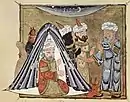


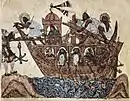 Arab dhow, c. 1230 AD, by an Iraqi painter.
Arab dhow, c. 1230 AD, by an Iraqi painter.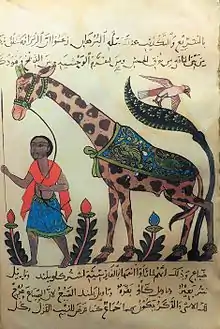 A giraffe from "Kitāb al-ḥayawān" (Book of the Animals) by Al-Jahiz.
A giraffe from "Kitāb al-ḥayawān" (Book of the Animals) by Al-Jahiz.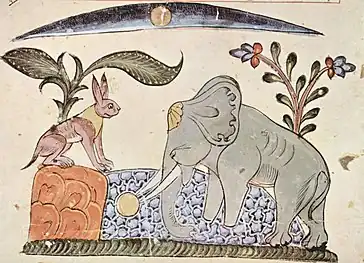 1310 Syrian illustration of "Kalila wa-Dimna".
1310 Syrian illustration of "Kalila wa-Dimna".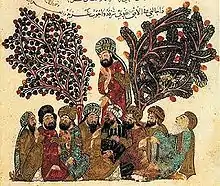 The Maqamat of Badi' al-Zaman al-Hamadani, 9th century.
The Maqamat of Badi' al-Zaman al-Hamadani, 9th century. "Kitāb mukhtār al-ḥikam" by Al-Mubashshir ibn Fatik, Syrian manuscript circa 1250.
"Kitāb mukhtār al-ḥikam" by Al-Mubashshir ibn Fatik, Syrian manuscript circa 1250.
See also
References
- ↑ Mihram, Danielle. "Research Guides: Medieval Studies and Research: Manuscripts: Art & Techniques". libguides.usc.edu. Retrieved 2022-05-27.
- ↑ "Miniature Painting". The David Collection. Retrieved 30 December 2017.
- ↑ "Islamic Miniature Painting and Book Illumination" (PDF). Bulletin of the Metropolitan Museum of Art. 28 (10): 166–171. October 1933.
- 1 2 von Bothmer, Hans-Caspar. Architekturbilder im Koran : eine Prachthandschrift der Umayyadenzeit aus dem Yemen. OCLC 258068564.
- ↑ Dutton, Yasin (2016). "Review of Qur'ans of the Umayyads: A First Overview (Leiden Studies in Islam & Society), François Déroche". Journal of Qur'anic Studies. 18 (1): 153–157. doi:10.3366/jqs.2016.0227. ISSN 1465-3591. JSTOR 44031130.
- ↑ Richard Ettinghausen, La Peinture arabe, Genève, Skira, 1977, 209 p.
- ↑ al-Jazari, The Book of Knowledge of Ingenious Mechanical Devices: Kitáb fí ma'rifat al-hiyal al-handasiyya, transl. & anno. Donald R. Hill. (1973), Springer Science+Business Media.
- ↑ "Baghdad school – Islamic art". Britannica. www.britannica.com. Retrieved 2022-05-23.
- ↑ Esanu, Octavian, ed. (2017-11-22). Art, Awakening, and Modernity in the Middle East. Routledge. doi:10.4324/9781315121970. ISBN 978-1-315-12197-0.
- ↑ "الكنوز الضائعة.. هكذا انتقلت أشهر المخطوطات العربية إلى مكتبات العالم المختلفة". ساسة بوست. 2017-08-30. Retrieved 2022-05-27.
- ↑ Thābit, Mahmūd; Albin, Michael W. (1977). "The Tragedy of Arabic Manuscripts, (1)". MELA Notes (12): 16–19. ISSN 0364-2410. JSTOR 29785032.
- ↑ Nongbri, Brent (2005). The use and abuse of P52 : papyrological pitfalls in the dating of the Fourth Gospel. [Harvard Divinity School]. OCLC 746495806.
- ↑ M. Stuiver & H. A. Polach, "Discussion: Reporting Of 14C Data", Radiocarbon, 1977, Volume 19, No. 3, pp. 355-363.
- ↑ Scott, E Marian; Cook, Gordon T; Naysmith, Philip (2007). "Error and Uncertainty in Radiocarbon Measurements". Radiocarbon. 49 (2): 427–440. Bibcode:2007Radcb..49..427S. doi:10.1017/s0033822200042351. ISSN 0033-8222. S2CID 59572018.
- ↑ "Virtual Manuscript Room". University of Birmingham. Archived from the original on 25 August 2015. Retrieved 25 July 2015.
- 1 2 "Birmingham Qur'an manuscript dated among the oldest in the world". University of Birmingham. 22 July 2015. Retrieved 22 July 2015.
- 1 2 "'Oldest' Koran fragments found in Birmingham University". BBC. 22 July 2015. Retrieved 22 July 2015.
- ↑ "Tests show UK Quran manuscript is among world's oldest". CNN. 22 July 2015. Retrieved 22 July 2015.
- ↑ Authi, Jasbir (22 July 2015). "Worldwide media frenzy as 'oldest Koran' found lying forgotten at University of Birmingham". Birmingham Mail. Retrieved 23 July 2015.
- ↑ "FAQs - University of Birmingham".
- ↑ "The Birmingham Qur'an Manuscript". University of Birmingham. Retrieved 2022-06-11.
- ↑ "FAQs". University of Birmingham. Retrieved 2022-06-11.
- ↑ "Codex Arabe 328c – A Qur'anic Manuscript From 1st Century Of Hijra". www.islamic-awareness.org. Retrieved 2022-06-11.
- ↑ Déroche, François (1983–1985). Catalogue des manuscrits arabes. Bibliothèque nationale. ISBN 2-7177-1396-4. OCLC 489708670.
- ↑ Déroche, François (2009). La transmission écrite du Coran dans les débuts de l'islam le codex parisino-petropolitanus. Brill. ISBN 978-90-04-17272-2. OCLC 494418883.
- ↑ S. Noja Noseda, "Note Esterne In Margin Al 1° Volume Dei ‘Materiali Per Un'edizione Critica Del Corano’", Rendiconti: Classe Di Lettere E Scienze Morali E Storiche, 2000, Vol. 134, Fasc. 1, pp. 19–25.
- ↑ W. Wright, Facsimiles Of Manuscripts And Inscriptions (Oriental Series), 1875–1883, The Palæographical Society, William Clowes and Sons, Ltd.: London, Plate LIX.
- ↑ Jenkins, Marilyn; al-Ahmad, Nasser Sabah (1983). Islamic art in the Kuwait National Museum: the al-Sabah Collection. Sotheby. ISBN 0-85667-174-6. OCLC 10098227.
- ↑ Y. Dutton, "Some Notes On The British Library's 'Oldest Qur'an Manuscript' (Or. 2165)", Journal Of Qur'anic Studies, 2004, op. cit., p. 44.
- ↑ al-Munaǧǧid, Ṣalāḥ-ad-Dīn (2002). Essays in honour of Ṣalāḥ al-Dīn al-Munajjid. Al-Furqān Islamic Heritage Foundation. ISBN 1-873992-70-X. OCLC 231972727.
- ↑ Déroche, François. Qur'ans of the Umayyads : a first overview. ISBN 978-1-306-21029-4. OCLC 973051902.
- ↑ Déroche, François (2017-12-21). "A Qurʾanic Script from Umayyad Times". Oxford Scholarship Online. doi:10.1093/oso/9780190498931.003.0003.
- ↑ F. Déroche, "Colonnes, Vases Et Rinceaux Sur Quelques Enluminures D'Époque Omeyyade", Comptes Rendus Des Séances / Académie Des Inscriptions & Belles-Lettres, 2004 (published 2006), pp. 227-264, esp. p. 237.
- ↑ S. al-Munajjid, Dirāsāt fī Tārīkh al-Khatt al-ʿArabī Mundhu Bidayatihi ilā Nihayat al-ʿAsr al-Umawi (French Title: Etudes De Paleographie Arabe), 1972, Dār al-Kitāb al-Jadid: Beirut (Lebanon), pp. 56-57, Figs. 26 and 27.
- ↑ T. Altikulaç, Hz. Osman’a Nisbet Edilen Mushaf- I Şerîf (Türk ve İslâm Eserleri Müzesi Nüshası), 2007, Volumes I and II, İslam Araştırmaları Merkezi (İSAM): Istanbul (Turkey).
- ↑ S. Şahin, The Museum Of Turkish And Islamic Arts - Thirteen Centuries Of Glory From The Umayyads To The Ottomans, 2009, Blue Dome Press: New York (NY), p. 23, pp. 24-25.
- ↑ T. Altikulaç, Hz. Osman’a Nisbet Edilen Mushaf- I Şerîf (Türk ve İslâm Eserleri Müzesi Nüshası), 2007, op. cit., pp. 106-107 (Volume I, Turkish section), pp. 120-121 (Volume I, Arabic section).
- ↑ S. al-Munajjid, Dirāsāt fī Tārīkh al-Khatt al-ʿArabī Mundhu Bidayatihi ilā Nihayat al-ʿAsr al-Umawi (French Title: Etudes De Paleographie Arabe), 1972, op. cit., p. 55.
- ↑ Altıkulaç, Tayyar (2007). Al-Muṣḥaf al-sharif : attributed to ʻUthmān bin ʻAffān : (the copy at the Topkapı Palace Museum). Research Centre for Islamic History, Art and Culture. ISBN 978-92-9063-167-5. OCLC 713324877.
- ↑ S. al-Munajjid, Dirāsāt fī Tārīkh al-Khatt al-ʿArabī Mundhu Bidayatihi ilā Nihayat al-ʿAsr al-Umawi (French Title: Etudes De Paleographie Arabe), 1972, Dar al-Kitab al-Jadid: Beirut (Lebanon), p. 55.
- 1 2 3 E. A. Rezvan, "On The Dating Of An “'Uthmanic Qur'an” From St. Petersburg", Manuscripta Orientalia, 2000, Volume 6, No. 3, pp. 19-22.
- ↑ A. Shebunin, "Kuficheskii Koran Imp. SPB. Publichnoi Biblioteki", Zapiski Vostochnago Otdieleniia Imperatorskago Russkago Arkheologicheskago Obshchestva, 1891, Volume 6, pp. 69-133.
- ↑ "Tashkent's hidden Islamic relic". 2006-01-05. Retrieved 2022-06-10.
- ↑ al-Munaǧǧid, Ṣalāḥ al-Dīn (1972). Etudes de paléographie arabe. New Book Publishing House. OCLC 469853665.
- ↑ La Peinture arabe, p.53-54
- ↑ La Peinture arabe, p.81
- ↑ La Peinture arabe, p.82-83
- 1 2 Bloom, Jonathan (2007). Arts of the City Victorious : Islamic art and architecture in Fatimid North Africa and Egypt. Institute of Ismaili Studies. New Haven. ISBN 978-0-300-13542-8. OCLC 165081886.
{{cite book}}: CS1 maint: location missing publisher (link) - ↑ Contadini, Anna (1998). Fatimid art at the Victoria and Albert Museum. Victoria and Albert Museum. London. ISBN 1-85177-178-6. OCLC 652126056.
{{cite book}}: CS1 maint: location missing publisher (link) - ↑ van Dyke, Yana; Centeno, Silvia A.; Carò, Federico; Frantz, James H.; Wypyski, Mark T. (2018-09-14). "On the formation of hörnesite in a Fatimid manuscript folio". Heritage Science. 6 (1). doi:10.1186/s40494-018-0221-2. ISSN 2050-7445. S2CID 53635955.
- ↑ La Peinture arabe, p.143-149
- 1 2 3 Massumeh, Farhad; Rettig, Simon (2016). The Art of the Qu'ran: Treasures from the Museum of Turkish and Islamic Arts. Washington, DC: Smithsonian Institution. pp. 104–105. ISBN 9781588345783.
- ↑ La Peinture arabe, p.183-184
- ↑ La Peinture arabe, p.135-142
- ↑ La Peinture arabe, p.179-181
- ↑ Terry, Allen (1988). Five essays on Islamic art. Solipsist Press. ISBN 0-944940-00-5. OCLC 19270867.
- ↑ Hoffman, Eva R. (2008-01-01). "Between East and West: The Wall Paintings of Samarra and the Construction of Abbasid Princely Culture". Muqarnas Online. 25 (1): 107–132. doi:10.1163/22118993-90000127. ISSN 0732-2992.
- ↑ La Peinture arabe, p.61-65
- ↑ La Peinture arabe, p.67-80
- ↑ Knipe, Penley; Eremin, Katherine; Walton, Marc; Babini, Agnese; Rayner, Georgina (2018-09-19). "Materials and techniques of Islamic manuscripts". Heritage Science. 6 (1): 55. doi:10.1186/s40494-018-0217-y. ISSN 2050-7445. S2CID 52832431.
- ↑ La Peinture arabe, p.83-97
- ↑ La Peinture arabe, p.120-124
- ↑ La Peinture arabe, p.125-128




























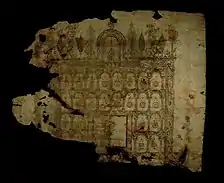
.jpg.webp)




_-_Bodleian_Library_-_Marsh_144.jpg.webp)



.jpg.webp)


_by_Ibn_Zafar%253B_verso-_The_Tale_of_the_Bear_and_the_M..._-_Google_Art_Project.jpg.webp)

_Walid_bin_Yazid.jpg.webp)







.jpg.webp)



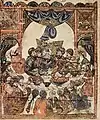


.jpeg.webp)